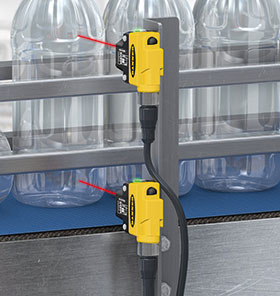

LED-based photoelectric sensors
Retro-reflective sensors are the most commonly used LED-based photoelectric sensor in clear object detection applications. Each sensor houses an emitter and a receiver. The emitter directs a beam of light to a reflector which redirects the light beam back to the receiver.
An object passing between the sensor and reflector will either block or attenuate a perceivable percentage of the emitted light.
How LED-based photoelectric sensors detect clear objects
Retro-reflective photoelectric sensors with a coaxial optical design emit and receive light along a single narrow axis. This optimises the detection of transparent objects by dramatically reducing the risk of false detection from reflected light. Sensors using this technology will have a small bright spot that simplifies sensor alignment and enables very precise leading edge detection.
Additionally, because light emitted and received travels on a single narrow beam, these sensors can see through a small aperture, allowing them to be shielded for use in wash down and hygienic environments. Photoelectric sensors with polarising filters will emit and detect light waves of a specific polarisation, ignoring all other light waves. This further reduces the risk of false detection caused by reflected light.
Advantages
Photoelectric sensors have faster response speeds, longer sensing ranges, and higher levels of precision than ultrasonic sensors. LED-based sensors are very effective for general use detecting larger objects and larger gaps between objects (compared to laser-based sensors).
Laser-based sensors
A laser-based sensor is another option for detecting clear objects. A laser-based sensor operates with a laser instead of an LED, allowing for easier alignment, greater precision, detection of smaller objects, and detection of smaller gaps compared to an LED-based sensor. Some laser-based sensors, like the Q4X from Banner Engineering, also do not require a retro-reflector or receiving unit.
How laser-based sensors detect clear objects
In addition to measuring distance, laser sensors with dual mode capability can also detect changes in light intensity from a stable background condition. In other words, a laser distance sensor with dual mode can detect not only when the target is present within a certain distance but also when it returns a certain amount of light to the receiver.
For this to work, a stable reference surface must be taught, and the distance and intensity of the reference surface are recorded and used as a baseline. The presence of a transparent object entering the sensing range of the beam alters the perceived distance and light intensity from the background condition.
Advantages
Laser-based sensors provide a highly visible laser spot for easy alignment, and a small laser spot ensures greater precision for detection of small objects. A laser-based sensor that does not require a reflector allows for more flexible mounting as well as reduced inventory and maintenance costs.
Ultrasonic sensors
Ultrasonic sensors use soundwaves to detect objects. Most ultrasonic sensors detect objects and measure distance by listening for the return echo of an emitted soundwave reflecting off of a target or background condition.
Opposed mode ultrasonic sensors, like the M25U from Banner Engineering, detect an object whenever the signal between the emitter and receiver is blocked. These sensors are faster and provide greater levels of precision than most ultrasonic sensors.
How ultrasonic sensors detect clear objects
Because ultrasonic sensors utilise sound rather than light for detection, they are not susceptible to many of the conditions which typically challenge optical sensors.
Advantages
Ultrasonic sensors are immune to target colour, reflectivity, and transparency, which simplifies product changeover and reduces downtime. Additionally, they are unaffected by area light conditions and perform well in dirty and wet environments.
For more information contact Brandon Topham, RET Automation, +27 (0)11 453 2468, [email protected], www.retautomation.com
| Tel: | +27 11 453 2468 |
| Email: | [email protected] |
| www: | www.turckbanner.co.za |
| Articles: | More information and articles about Turck Banner Southern Africa |

© Technews Publishing (Pty) Ltd | All Rights Reserved